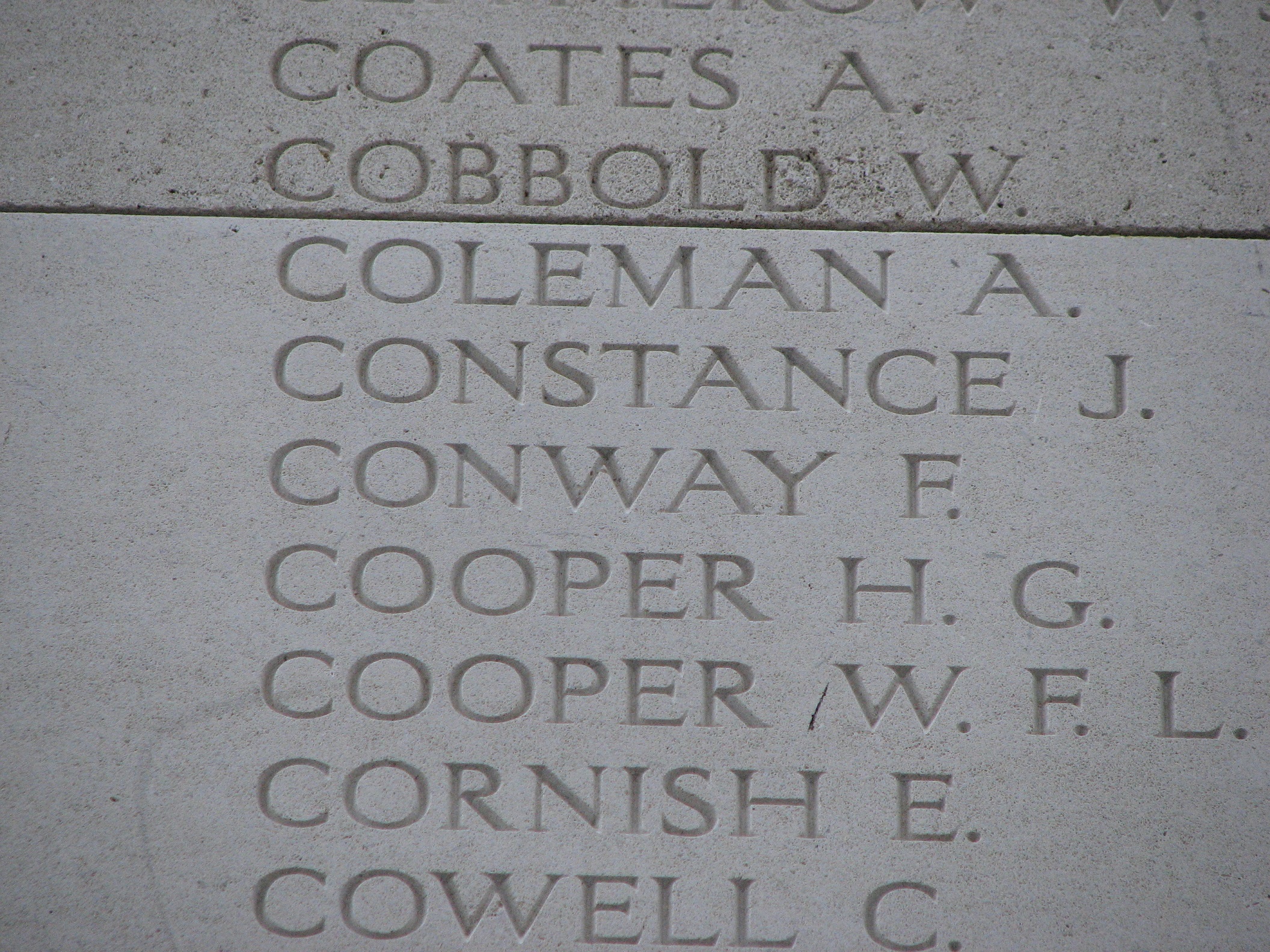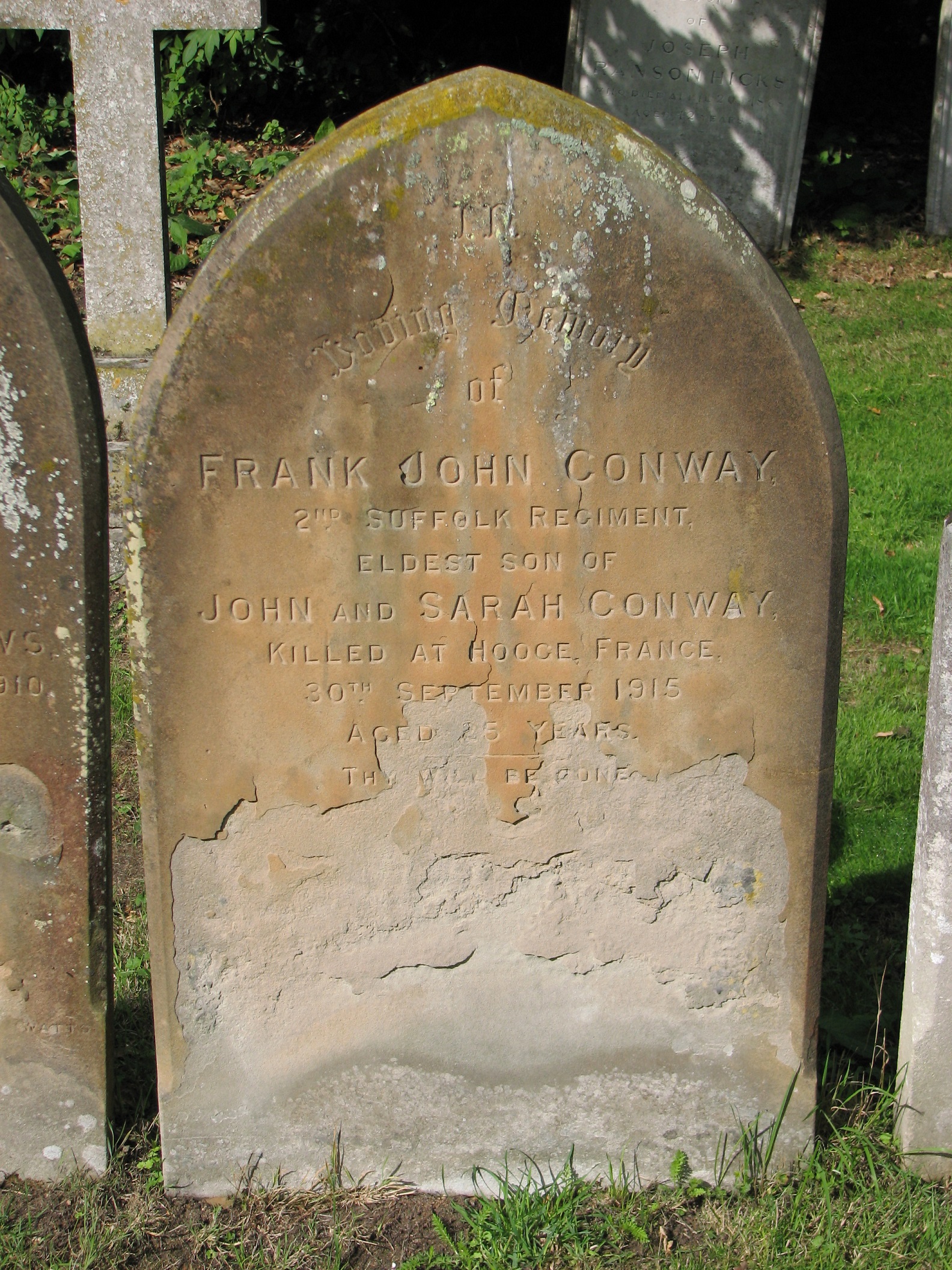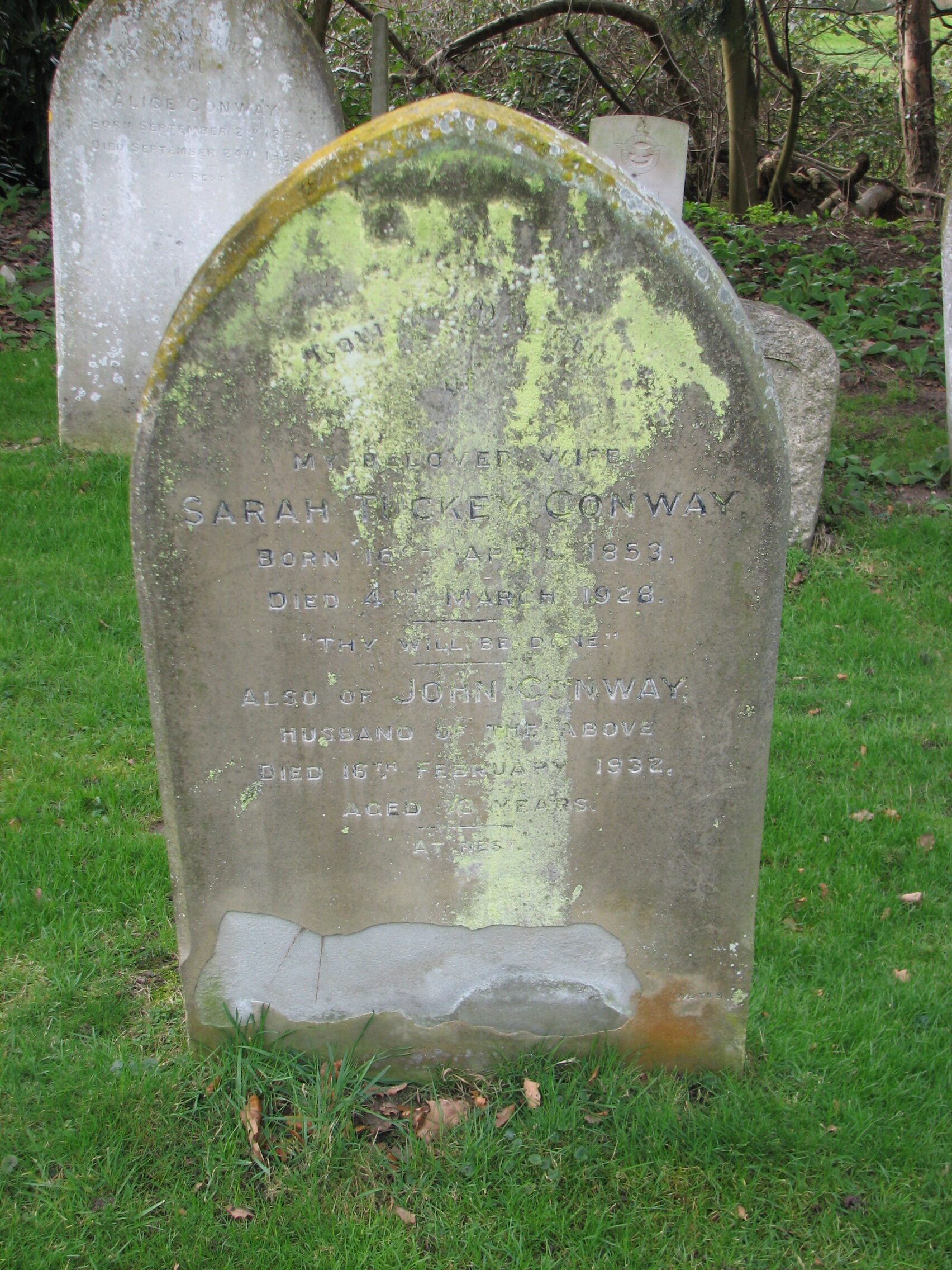Frank Conway (1890 - 1915)
Having worked before the war as a Horseman on a farm, Frank volunteered to join the Cavalry in 1914. He was transferred to the Infantry before being sent overseas where he served in Flanders with 2nd Battalion of the Suffolk Regiment.
- 25
- Died in the Great War
- 51.979814, 1.021406
Details
| Name: | Frank John Conway 1 Frank’s name is incorrectly shown as F.G. Conway rather than F.J. Conway on the East Bergholt Roll of Honour, which records the names of the “East Bergholt Men Who Served in the War of 1914 to 1919”. Whether this was always incorrect, or whether the error occurred during the restoration of the Memorial in the 1990s is not clear. |
| Service: | British Army |
| Unit: | 2nd Battalion, Suffolk Regiment |
| Regimental Number: | 19228 |
| Rank: | Private |
| Date of Death: | 30th September 1915 |
| Age: | 25 |
| Commemorated: | Panel 21, Menin Gate Memorial, Ieper (Ypres), Belgium |
Family Background and Early Life
Frank Conway was born in East Bergholt on 22nd June 1890, the eldest child of John and Sarah Conway.
John Conway was a Jobbing Gardener who had been born and raised in East Bergholt. In 1889 he had married Sarah Tuckey Dilworth from Trowbridge in Wiltshire, and together they would have 4 children, 3 boys and a girl. 2 Two of Frank’s brothers also served in the Great War:
Fred Conway served in the Royal Flying Corps and it’s successor, the Royal Air Force. He survived the War.
William – or Bill as he was known – also survived the War. He served with the 2nd Battalion of the Essex Regiment on the Western Front and was wounded. The severity of his wounds meant that he was discharged from the Army in 1916 on medical grounds.
The Conways made their home on Gaston Street (at that time just called The Street), and lived there until they moved to High Trees Cottage sometime between 1901 and 1911.
Frank started at the village school at Burnt Oak Corner when he was 4 and remained as a pupil there for a little over 8 years, leaving on his thirteenth birthday.
After leaving school Frank – like many of his contemporaries in the village – was employed in agriculture and became a Horseman on a farm. As with many of those who work with horses, it is likely that Frank had great affection for the animals: When he volunteered to join the Army he requested to join the Hussars, which was a Cavalry regiment.
Joins the Army
There is no surviving official documentation to record exactly when Frank joined the Army, but there is strong evidence to indicate that it was probably in September or October 1914. He was sent initially to a training unit, and certainly by the late spring of 1915 was serving with the 13th Reserve Regiment of Cavalry. The 13th trained men for a number of Cavalry units, including two battalions of the Hussars.
Following the influx of volunteers into the Army after the outbreak of war in August 1914, it became apparent to the Army High Command that they now had too many men in Cavalry units. As a result, during the course of the war more and more men were transferred from the Cavalry to the Infantry. Frank was one of those affected by this, when – in early June 1915 – he and many others from the 13th were transferred to the Suffolk Regiment.
France and Belgium
Frank disembarked in France on 6th July 1915, and joined the 2nd Battalion of The Suffolk Regiment in the field later that month.
The 2nd Battalion had been in France since August 1914 – one of the original units of the British Expeditionary Force (B.E.F.). They were a pre-war battalion, and when they first arrived in France had been made up entirely of Regular soldiers or Reservists. They had suffered some heavy casualties over the previous 9 months, so that by mid 1915 most of the replacements were wartime volunteers.
At the time that Frank joined the Battalion, they were serving in the infamous Ypres Salient, in Belgium – helping to defend the beleaguered city which in many ways came to be regarded as a symbol of Britain’s resolve and sacrifice. Amongst those already serving with the 2nd Suffolks were two local men, Edwin Mower from East End and Bertie Randall from Cattawade. 3 Edwin Mower, a pre-war Reservist had been with the Battalion in France and then Belgium since August 1914. Edwin was killed in action on 1st October 1915, aged 29, and is buried in the Sanctuary Wood Cemetery.
Bertie Sumner Randall had joined up in September 1914 and been with the Battalion in Belgium since January 1915. Bertie was killed on 16 August 1915, aged 22 and is buried in the Spoilbank Cemetery.
The Battalion spent most of August in the line along the south bank of the Ypres-Commines Canal, near Spoilbank just south of Ypres. They suffered casualties on most days – one of those killed was Bertie Randall.
The 2nd Suffolks came out of the line on 23rd August and back to the rear, where they went into billets. After ten days, most of the Battalion went into dugouts located approximately 2 miles behind the Front Line. Whilst here they were not actually manning the Line, but from the 3rd to 23rd September they were engaged in pioneering tasks, mainly digging trenches at the Firing Line or just to the rear. It was hard, dirty and dangerous work – during this period the Battalion lost 19 men, 1 killed, 17 wounded and 1 who committed suicide. 4 The Regimental History states “In order to cope with the vast amounts of pioneering work which stationary warfare demands, the system of earmarking a battalion for this special duty was introduced in some brigades. All the Suffolk battalions bore a good reputation for digging as well as fighting, and it befell the 2 Battalion to act in this capacity on and off from July to September. The lot of the pioneer battalion in front of Ypres was surely no light one . It was usually in the trench area for longer periods at a time than a battalion holding the line, and when an attack was in progress it was held in reserve, as often as not to be swept into the trail of the storm.” (“The History of the Suffolk Regiment 1914-1927”, by Lieutenant-Colonel C.C.R. Murphy, Hutchinson & Co., 1928).
Sanctuary Wood
On 25th September, the 2nd Suffolks relieved another Battalion in the front-line trenches in Sanctuary Wood, approximately 3 miles from Ypres. Four days later, the Germans exploded a large mine under the trenches manned by one of the Suffolk’s neighbouring battalions. Despite a counter-attack which involved some of the 2nd Suffolks, the Germans succeeded in capturing that part of the line.
The following day, after a supply of bombs (hand grenades) were received, the British made up a scratch force – consisting of a Company from each of the following battalions – 4th Middlesex, 2nd Royal Scots and 2nd Suffolks: They were to launch a counter-attack to recapture the lost trenches around the mine crater.
The attack was launched at 3.15 that afternoon. In the face heavy opposition including rifle fire and grenades, the 2nd Suffolks managed to make it to edge of the mine crater, before enfilade machine gun fire forced them to retire.
This failed counter-attack had cost the 2nd Suffolks dearly, and they suffered 120 casualties including 35 dead. One of those who had been killed was Frank, aged 25.
Frank has no known grave and is officially commemorated on the Menin Gate Memorial to the Missing, in Ypres, just three miles from where he fell.
The Menin Gate Memorial to the Missing bears the names of more than 54,000 Commonwealth War dead who died in the Ypres Salient during the Great War, and who have no known grave. 5 The Menin Gate Memorial does not include the names of the New Zealand Missing from the Ypres Salient, nor those from the United Kingdom who died in the Salient after 16th August 1917, and who have no known grave. They are commemorated on other Memorials in the area.
Postscript
Frank’s parents lived in East Bergholt for the rest of their lives. Sarah Tuckey Conway died in 1928 at the age of 74 and John Conway died at the age of 73 in 1932. They are buried in East Bergholt Cemetery.
Frank is also remembered on a memorial stone erected by his family in East Bergholt Cemetery. The inscription states that he was killed at Hooge, France. Hooge is the nearest hamlet to Sanctuary Wood, but it is located in Belgium not France.
Copyright © Mark Ashmore, 2024
- 25
- Died in the Great War
- 51.979814, 1.021406




